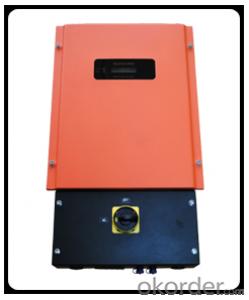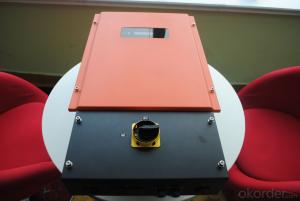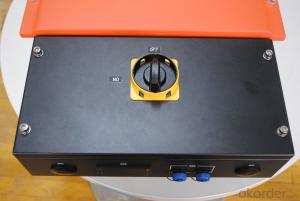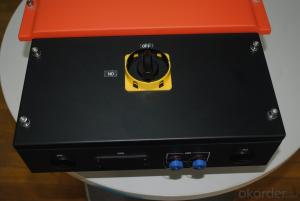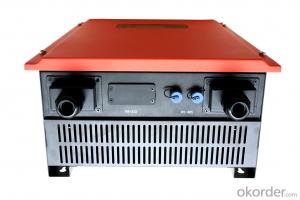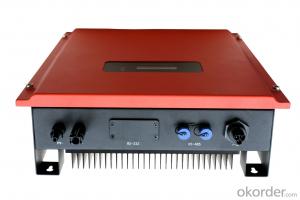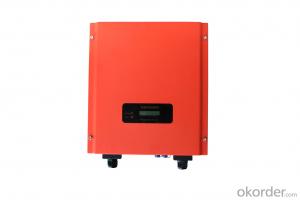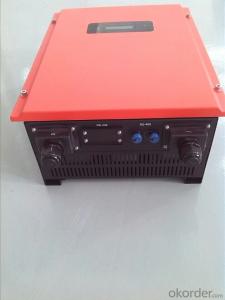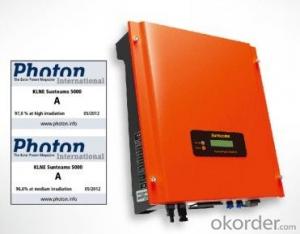12V MPPT Solar Inverter Sunteams 1500-3000 (US) ETL with Wirebox
- Loading Port:
- China Main Port
- Payment Terms:
- TT OR LC
- Min Order Qty:
- -
- Supply Capability:
- -
OKorder Service Pledge
OKorder Financial Service
You Might Also Like
The Sunteams (US) 1500 ~5000 series isapplicable to various rooftops and small scale photovoltaic grid connected power plants. Their nominal output powers are 1.5 kW, 2 kW, 3 kW, 4 kW and 5kW respectivelywith Certificate ETL (220V/60HZ).
This series is transformerless and has a wide range of MPPT input voltage. Itsmaximum conversion efficiency and MPPT tracking accuracy reach 97.6 % and 99.5% respectively. The maximum DC voltage reaches 550 V. Its multilingualLCD display facilitates easy operation. It has waterproof direct plug interminals. It has overvoltage, islanding, short circuit, overloading andoverheating protection functions. Its IP65 protection degree will ensure itruns well in various tough environments.
- Q: How does MPPT technology work in solar inverters?
- MPPT (Maximum Power Point Tracking) technology in solar inverters works by continuously adjusting the operating voltage and current of the solar panels to ensure the maximum power output. It does this by constantly monitoring the voltage and current of the solar panels and finding the optimal point (maximum power point) at which the panels can deliver the most power. This is achieved by varying the load on the panels to match their impedance with the maximum power point. MPPT technology maximizes the efficiency of solar power generation by extracting the maximum available power from the panels under varying environmental conditions such as shading, temperature changes, and panel degradation.
- Q: What is the maximum temperature range for a solar inverter?
- The maximum temperature range for a solar inverter typically depends on the specific model and manufacturer. However, most solar inverters are designed to operate within a range of -20°C to 50°C (-4°F to 122°F).
- Q: How does the harmonic distortion affect the performance of a solar inverter?
- Harmonic distortion can have a negative impact on the performance of a solar inverter. It can lead to increased heat generation, reduced efficiency, and can even cause damage to the inverter components. Additionally, harmonic distortion can introduce electrical noise into the system, which can affect the quality of the output waveform and potentially interfere with other connected devices. Therefore, minimizing harmonic distortion is important to ensure optimal performance and reliable operation of a solar inverter.
- Q: How does a solar inverter handle islanding detection and prevention?
- A solar inverter handles islanding detection and prevention by constantly monitoring the grid and its own power output. If it detects a loss of grid connectivity, it initiates a process called anti-islanding, where it stops supplying power to the grid to prevent the formation of an island. The inverter accomplishes this by monitoring the frequency and voltage levels of the grid, and if it detects a deviation beyond a certain threshold, it disconnects from the grid within a specific timeframe. This ensures that the inverter does not continue to supply power to an isolated grid, which could pose safety risks to utility workers and damage electrical equipment.
- Q: Are there any maintenance requirements for solar inverters?
- Yes, solar inverters do require regular maintenance to ensure optimal performance and longevity. This can include cleaning or replacing air filters, inspecting and tightening electrical connections, checking for any physical damage or corrosion, and updating firmware or software as needed. Additionally, monitoring the inverter's performance and generating reports can help identify any issues or inefficiencies that may require maintenance or repairs.
- Q: What are the key factors affecting the lifespan of a solar inverter?
- The key factors affecting the lifespan of a solar inverter include the quality and durability of its components, proper maintenance and regular servicing, the operating environment, the load capacity, and the level of electrical stress it experiences.
- Q: Can a solar inverter be used with building-integrated photovoltaics (BIPV)?
- Yes, a solar inverter can be used with building-integrated photovoltaics (BIPV). BIPV systems are designed to seamlessly integrate solar panels into the building structure, providing both energy generation and architectural functionality. Solar inverters play a crucial role in BIPV systems by converting the direct current (DC) produced by the solar panels into alternating current (AC) that can be used to power electrical devices in the building or fed back into the grid.
- Q: Can a solar inverter be used with different types of communication interfaces?
- Yes, a solar inverter can be used with different types of communication interfaces. Many modern solar inverters are designed to be compatible with various communication protocols such as Wi-Fi, Ethernet, RS485, and Zigbee. This allows for easy integration and monitoring of the inverter with different types of communication systems and devices.
- Q: What is the role of a solar inverter in fault ride-through capability?
- The role of a solar inverter in fault ride-through capability is to help maintain the stability and reliability of the power grid during faults or disturbances. By detecting and responding to voltage and frequency variations caused by faults, the solar inverter can adjust its output and remain connected to the grid, ensuring continuous power supply. This capability is essential for grid stability and allows solar power systems to contribute to the overall reliability of the electrical network.
- Q: Can a solar inverter be remotely monitored and controlled?
- Yes, a solar inverter can be remotely monitored and controlled. Many modern solar inverters are equipped with built-in communication capabilities, allowing them to be connected to a monitoring system or software. This enables users to remotely monitor the performance, efficiency, and power output of their solar inverters, as well as control various settings and parameters. Remote monitoring and control of solar inverters can provide real-time data, fault detection, and even allow for performance optimization, making it easier for owners or operators to manage and maintain their solar energy systems.
Send your message to us
12V MPPT Solar Inverter Sunteams 1500-3000 (US) ETL with Wirebox
- Loading Port:
- China Main Port
- Payment Terms:
- TT OR LC
- Min Order Qty:
- -
- Supply Capability:
- -
OKorder Service Pledge
OKorder Financial Service
Similar products
Hot products
Hot Searches
Related keywords
